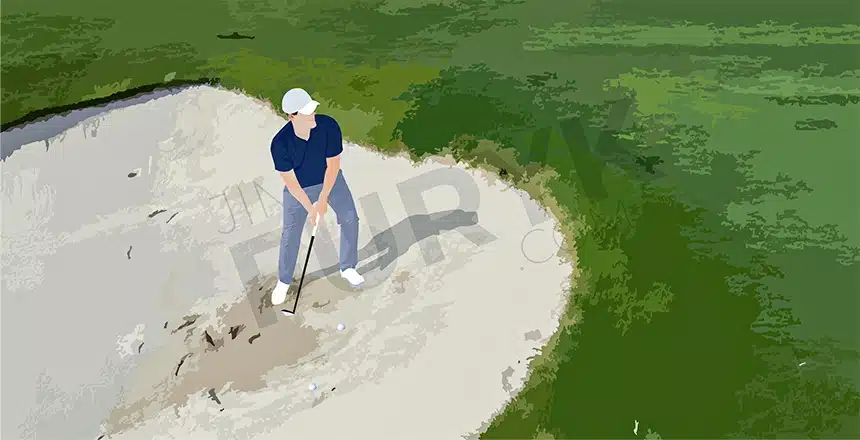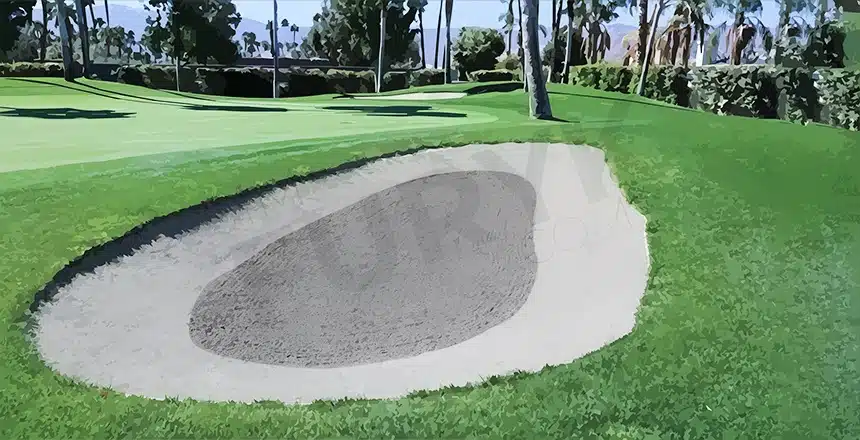How well you hit out of sand is why there are bunkers designed in golf courses. These sanded areas exist to test your abilities as a golfer. Near the fairway or green, a bunker is natural or manmade, right?
Before we delve deeper into the topic of what is a bunker in golf, you should know that there are three types of bunkers, fairway, greenside, and waste bunkers. Needless to say, how deep and big or small these are and also how they’re shaped – these factors are not the same from one kind of bunker to another.
Also, did you know that bunkers are often known as “traps” as well? However, officially speaking, meaning the USGA and R&A refer to them only as bunkers, and not the slang version “traps.”
So it’s time to get to know all about golf bunker construction, purpose, rules, and the different types of bunkers in golf.
Oh and here’s how Tiger Woods struck one of the most exceptional long bunker shots back in 2019. And here’s a very fitting example of the use of the term ‘bunker’ in the game of golf – “Spieth holes out from the bunker for a birdie and the win in sudden death on the par-4 18th hole.”
In This Post
Loose Definition of “Bunker”

In the simplest terms, bunkers are specially prepared or designed for testing the abilities of players when they play the golf ball from inside the sanded area.
Previously called hazards, their name was deprecated in the year 2019, bunkers are nothing but depressions or holes in the turf/ground. They can be either manmade (i.e. deliberately constructed there) or natural. And, obviously, bunkers are filled with sand (or sand-like material).
The size of bunkers varies vastly, and this applies to their depth and shape too.
Your putting greens, more often than not, are guarded by bunkers. Although bunkers are also very commonly found alongside and in fairways. And when you hit a stroke out of the bunker, that’s known as a bunker shot. You can casually also refer to bunkers as sand bunkers, traps, or sand traps. But, officially, only the golf term “bunker” applies.
Other slang terms for bunkers are sandbox, beach, cat box, and kitty litter.
There are just a few golfing terms that have survived through centuries (since the 18th century) and are still in use now in the 21st century. One of them being “bunker” of course. In the old days, a bunker was only a small-sized, deep pit full of sand.
Now it goes without saying that bunker shots have to be played a certain way. Meaning there are rules for what’s allowed and what’s not allowed. These rules (in the rule book – Bunkers belong to the ‘Rule 12’ category) also include a video and diagram for helping you understand more about what’s permitted and what’s not when playing the shot from inside the bunker.
The Official Meaning of “Bunker” According to Golf Rules
From the USGA website > Rule 12 – Bunkers:
“Purpose of Rule: Rule 12 is a specific Rule for bunkers, which are specially prepared areas intended to test the player’s ability to play a ball from the sand. To make sure the player confronts this challenge, there are some restrictions on touching the sand before the stroke is made and on where relief may be taken for a ball in a bunker.”
Now, based on this official definition of the term ‘bunker’ in the sport of golf, the following areas/situations do not fall under the jurisdiction of bunkers…
A face, lip, or wall along the prepared bunker area’s edge containing stacked turf, grass, soil, or any artificial materials – not a part of bunkers!
Any natural object (trees, grass, or bushes) or even soil attached to the inside of the prepared area – not a part of bunkers!
Sand that is outside or spills over the bunker’s edge – not a part of bunkers!
Other sanded areas on the golf course not inside the prepared area’s edge (for example, naturally sanded sections, deserts, etc.) – not a part of bunkers!
Different Types of Bunkers In Golf
There are all kinds of bunkers and they come with their own individual names, so here’s the definition of each…
1. Fairway Bunkers
Both sides of the fairway consist of fairway bunkers, hence it’s most likely that your off-the-tee shots will find one of those bunkers.
Now once your golf ball lands in the fairway bunker, you have two options:
- Aim straight for that green!
- Play safe instead and get the ball back out on the fairway.
The decision is all yours! The first choice, needless to say, is the more aggressive and challenging one! Even the pros choose to play safe unless they find themselves in a sticky situation, such as a bad lie or if the distance between the hole and the green is too long.
2. Greenside Bunkers
Any bunker that is near the putting green is called a greenside bunker (guardians of the green!). When approaching the green, that is when hitting approach shots, that’s when greenside bunkers become a part of your game.
Getting out of these types of bunkers in golf rounds demands special skills in the form of solid contact but with soft hands. Otherwise, your shots will end up flying over that green when hit too hard.
3. Cross Bunkers
These kinds of bunkers are positioned in a way that leads you to cross over that bunker on a particular hole (when the line of play is normal). Approach shots, tee shots, and layup shots can land in such cross bunkers.
Cross bunkers are normally thinner and longer in comparison to their greenside and fairway counterparts. But the size and shape differ; the only constant is that the whole concept of cross bunkers is that they are placed perpendicularly to the play line.
The placement is such that you’re compelled to shoot over the bunker, so the golf ball flies over the fairway, in the direction of the green.
4. Pot Bunkers
An entirely different type of sand bunker, a pot bunker is very deep, smaller, and perfectly round. You find pot bunkers on link golf courses since these kinds of courses, due to the lack of too many hazards, could use this kind of an extra layer or aspect of difficulty.
Pot bunkers are found around the green or in the rough or fairway. They’re also referred to as potholes or pothole bunkers.
5. Waste Bunkers
Not technically or officially treated as hazards, waste bunkers are not the same as your regular or typical sand bunkers. Therefore, the official rules to play from a hazard are not applied in this case. Meaning you’re free to ground your golf club into the sand for taking practice swings – something that’s not allowed when faced with conventional sand bunkers.
6. Church Pews Bunkers
These are long bunkers where the length is combined with the rough. Very rare to come across, church pews bunkers are actually quite popular at the Oakmont Country Club.
The church pews at the club consist of relatively deeper and more grass, not sand. As for the grass bunker there, it isn’t really a bunker. Rather it’s more like rough. And here too, the official rules of playing from a hazard don’t apply, just like waste bunkers.
Frequently Asked Questions (FAQs)
What’s the Difference Between Bunker and Sand Trap?
First of all, sand traps are manmade pits filled with sand, while bunkers are depressions in the turf or ground (and these depressions can be either manmade or natural). The latter is not always equipped with sand, rather you find in it long grass, gravel, dirt, pine needles, or sand.
If the bunker doesn’t contain sand, then it’s normally called a waste bunker.
Secondly, manmade sand traps are positioned very strategically so the game of golf becomes a bit more challenging for you. Whereas bunkers i.e. shallow depressions with pine needles, dirt, etc. are found about 200 yards from the green. Sand traps, on the other hand, are just a few yards away from the hole.
With that logic, sand traps should be considered hazards, correct? Yes, absolutely! Thus, official rules should be adhered to when you hit the golf ball from this particular hazard. But when the ball lands inside a bunker, there’s no need for following any hazard rules, such as grounding.
And finally, for sand-trap shots, you can only use your wedge golf club. More specifically, your sand wedge! But bunker shots make way for more flexibility; hence you have more club options. So you get to pick a golf club that is the most suitable (different types of golf wedges explained) for the material or materials that the bunker contains.
What Is A “Bunker” In Golf Also Called?
‘Sand trap’ is the slang term used for a bunker in golf. The latter is the official name of course, while the former is just what players say casually.
How Many Bunkers Are In A Golf Course?
Usually, there are three different types of bunkers on golf courses. These many are enough when it comes to making the design or architecture of the course adequately challenging for golfers.
Bunkers are, in fact, deliberately and strategically positioned impediments to the progress of the player when he/she is approaching the green.
Is A Sand Trap A Hazard?
A sand trap, if I may, is a classic hazard in every round of golf, much like a water hazard. Therefore, there are official rules for when you’re playing from such a hazard.
The EndNote
Bunker shots are strokes you play out of bunkers – it’s as simple as that, almost.
In this post, I’ve talked about every important aspect related or relevant to a bunker in golf. What is a bunker, different types of bunkers, bunker construction, and more – these topics are all covered!
Just know that most golfers, including me and my fellow golfing buddies, use the terms bunker, sand bunker, trap, and sand trap interchangeably. But, officially, it’s only called “bunker.”

